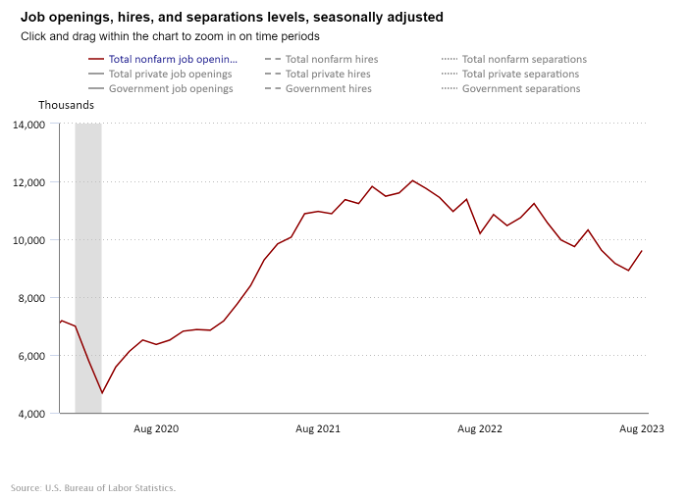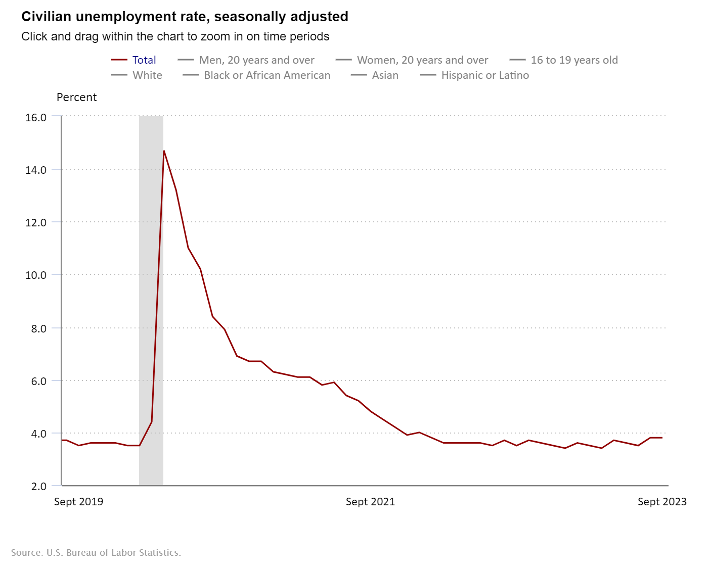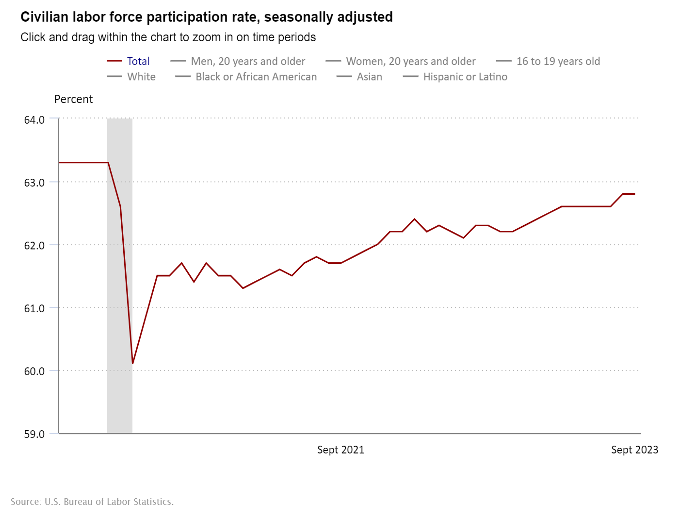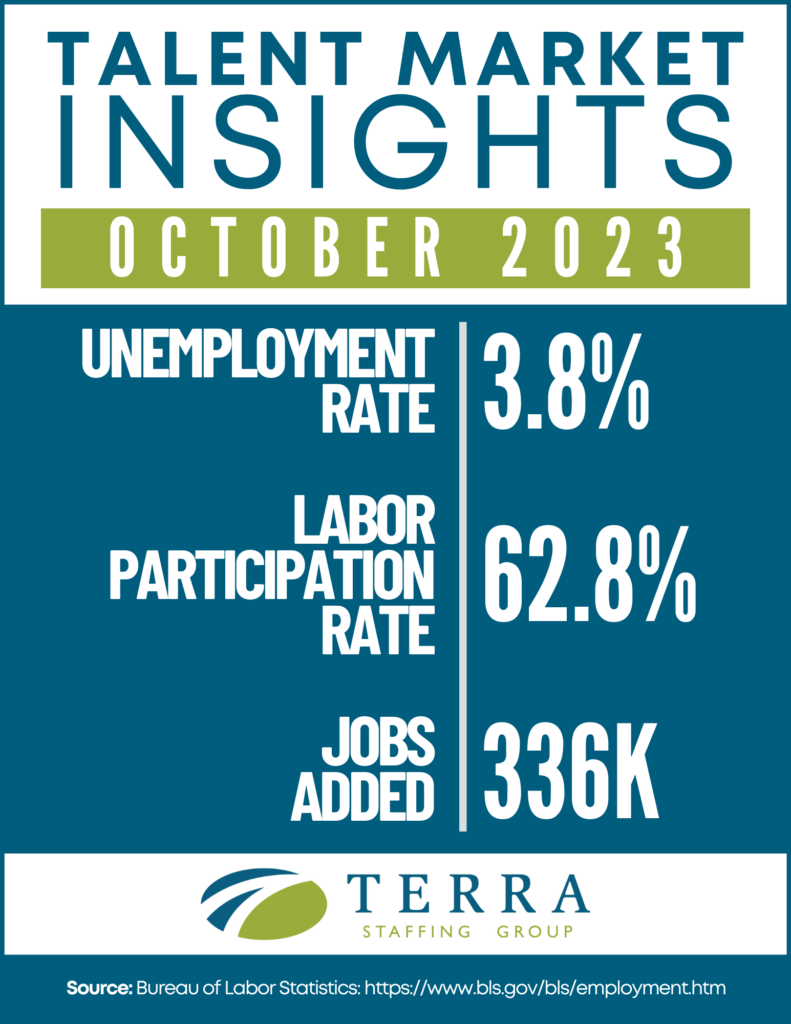October 2023 Talent Market Insights
Posted on October 18, 2023
The U.S. labor market is “too hot to handle.”
336,000 jobs were added last month, nearly double economists’ 170,000 prediction, and the highest month in jobs added since January this year.
Job gains for July and August were revised up to a combined 119,000, putting each month over 200,000 in jobs added, and showing a more potent hiring trend this summer.
Yet, this suggests that the labor market is not cooling off as Feds had hoped and may lead to another interest rate hike in an effort to combat inflation.
Let’s discuss what’s going on in today’s talent market and how this impacts employers.
Key Takeaways:
- Unemployment remains unchanged at 3.8%.
- 336,000 jobs were added for the month of September, far exceeding expectations.
- With more workers available, wage growth has moderated.
- Leisure and hospitality, government, and healthcare & social assistance led the way in jobs added.
Number of Jobs Available

The number of job openings is continuing to outpace hires.
There are 9.6 million total non-farm openings, an increase from July and showing a return to the high post-pandemic numbers in 2021 and 2022.
Leisure and hospitality added 96,000 jobs—61,000 of which were jobs added in food services and drinking places, which have returned to their pre-pandemic February 2020 level.
Government jobs were also a leading category in jobs added, and increased by 73,000, a 34% increase above the average monthly gain of 47,000 over the last 12 months.
Unemployment

Unemployment remained unchanged at 3.8%, though it was predicted to drop to 3.7% in September.
Possible contributors to the unemployment rate could be the various strikes throughout the month.
One of them, the Hollywood Writer’s Strike, has come to an end, but others have either taken effect or are still ongoing, which may impact future unemployment data.
Worth noting is that job searches have increased for the second consecutive month, bringing us closer to the levels seen in September last year.
Workforce Participation

Workforce participation is holding steady at 62.8%.
Hires changed little from 5.7 million to 5.9 million and the employment rate remains at a high of 60.4%.
Women aged 25-54 are still holding a record-high employment rate, at 75.3% for the sixth month in a row.
And up until the United Automobile Workers strike in mid-September, motor vehicle and parts manufacturing industries had their highest employment since June 2006.
Wage Growth
For the second consecutive month, September saw a 0.2% wage growth increase, just shy of the projected 0.3%.
And the annual pay gain was 4.2%, the lowest it’s been since June 2021.
One possible reason for moderated wage growth may be the influx of new entrants to the
workforce. With more job seekers available, employers may be feeling less pressured to raise pay to attract talent.
Economic Variables to Keep an Eye on
Various factors can influence the economic landscape. Here are some that may have implications in the coming months:
Inflation: Strong job gains may cause concern for Feds, who are keeping a close eye on inflation—and investors who fear an interest rate hike may be on the horizon.
Labor strikes: Multiple labor strikes in flux could have far-reaching effects on wage growth, unemployment, and workforce participation in the months ahead.
Consumer spending:
Student loans: Student loan payments have resumed. This may influence the way people allocate their resources and affect overall economic dynamics.
Savings: Americans have reached historic lows when it comes to personal savings. This trend could have implications on future consumer spending patterns and is one to keep an eye on.
What does this mean for employers?
While wage growth is moderate and more workers are available, the job market remains competitive. Here are some winning strategies for employers to stay ahead of the competition.
Stay attractive to talent. Ensure your pay and benefits are equitable and in line with industry benchmarks. Offer training, growth, and unique perks to both attract and retain employees.
Source top talent from within. Turnover is costly. Encourage internal growth and promote a culture that celebrates upward mobility. Show employees the opportunities within the organization—or they’ll seek them outside.
Cast a wider recruiting net. Consider tapping into alternative talent sources. Embrace the fear of missing out (FOMO) in your hiring strategy. Who might you be overlooking? Avoid missing out on great talent by broadening your search.
Consider temporary staffing. Temporary staffing can provide some breathing room in a tight economy. Not only can it be more cost-effective for your business, but it can also help ensure productivity goals and project deadlines are met, regardless of the market.
As we continue to navigate the nuances of the job market, we want to be a resource for you.
Don’t hesitate to contact us for a deeper understanding of current market trends. We’re here to help you make informed decisions about your staffing needs.
Categories: Staffing Tips & Recruiting Trends
Tags: job market data, labor market trends, Talent Market Insights, Talent Market Insights October 2023





